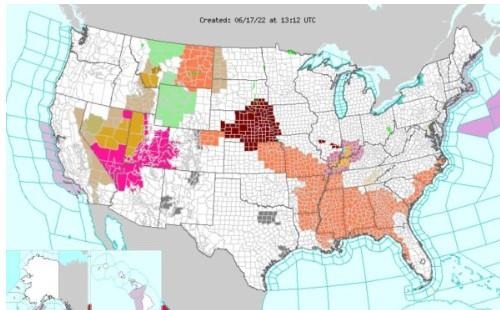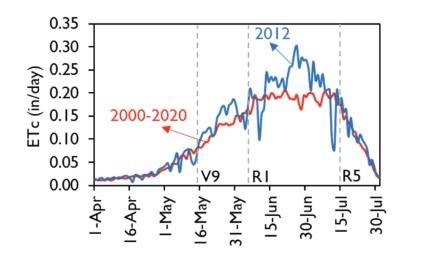The current heat wave along with the dry spell occurring this week—which may extend through the next couple of weeks—might put corn fields at risk for yield losses if irrigation is not managed properly. Corn fields planted in mid-April across Alabama are now at tasseling (flowering period). This is one of the most critical growth stages in crop production, so days with temperatures above 95oF might impact pollination, and even grain filling. Figure 1 shows the current weather alerts set by the national weather service. Most counties in Georgia, Alabama, and Mississippi (colored with orange on the map) are under a heat advisory.

Figure 1. www.weather.gov
Heat May Affect Pollination
The heat and dry conditions many corn fields are experiencing could kill pollen, affecting pollen supply. The drought conditions combined with heat could impact silk elongation, or even cause desiccation of exposed silks. This would impact overall silk fertilization and kernel development. The use of irrigation to provide adequate soil moisture to the plant could minimize the risk for corn yield losses during these critical reproductive growth stages.
Water Demand
The corn plant’s water demand reaches its peak at tasseling and remains high from silking to the early dent growth stages. Irrigation is normally used to supply the water loss by crop transpiration and soil evaporation, a process called crop evapotranspiration. Daily changes in ambient temperature, relative humidity, solar radiation, and wind speed affect daily evapotranspiration. In the end, this will affect the rate of irrigation required to meet crop evapotranspiration.
Figure 2 shows the historic average values of corn crop evapotranspiration for a location in the northwest region of Alabama. The graph also shows that in dry years, crop evapotranspiration could be much higher than the average—especially during the peak of corn water use. The historic corn evapotranspiration average value during tasseling and silking is around 0.20 inches per day. However, during hot days above 95oF, it could reach values of up to 0.30 inches per day. During days with no rain, irrigation should be used to meet crop evapotranspiration and this is even more crucial when the crop is growing on soil with low water holding capacity.

Figure 2. The historic average values of corn crop evapotranspiration for a location in the northwest region of Alabama.
Don’t Wait to Water
Farmers should not wait for rain—especially in June—because the historic records show that June rainfall does not always meet corn water demand. Figure 3 shows historic values of rainfall and corn evapotranspiration in the month of June for one location in Alabama. In Courtland, Alabama rainfall (blue color bars) did not supply or meet corn water demand (gray bars) in 14 out of 20 years of historic records (Figure 3). Applying the right irrigation rate to meet corn water demand and at the right time could prevent yield losses.

Figure 3. Historic values of rainfall and corn evapotranspiration in the month of June in Courtland, Alabama.
La Niña
The lack of rainfall experienced this month of June could be related to La Niña phase of El Niño Southern Oscillation (ENSO). The most current ENSO forecast issued by NOAA indicates that our climate has been influenced by La Niña phase and this phase could persist through at least the month of June with the possibility (52% probability) of it weakening in late summer (https://www.cpc.ncep.noaa.gov/products/analysis_monitoring/enso_advisory/ensodisc.shtml).
The historic records of June rainfall data for years when the climate was influenced by the La Niña phase shows rainfall below the historic records for many locations across Alabama. You can read more about La Niña in ANR-2091, El Niño-Southern Oscillation and Its Impact on Alabama’s Climate.
Source : aces.edu